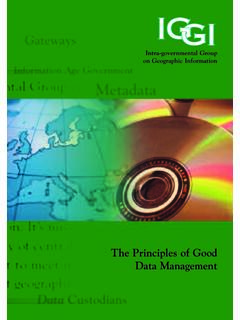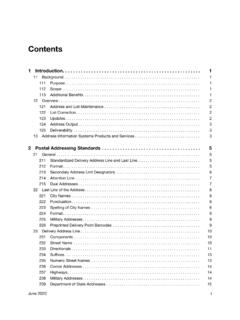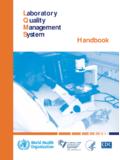Transcription of 9 GIS Data Collection - Dawn Wright
1 9. GIS data Collection OVERVIEW. This chapter reviews the main methods of GIS data capture and transfer and introduces key practical management issues. It distinguishes between primary (direct measurement) and secondary (derivation from other sources) data capture for both raster and vector data types. LEARNING OBJECTIVES. Describe data Collection workflows;. Understand the primary data capture techniques in remote sensing and surveying;. Be familiar with the secondary data capture techniques of scanning, manual digitizing, vectorization, photogrammetry, and COGO feature construction.
2 Understand the principles of data transfer, sources of digital geographic data , and geographic data formats;. Analyze practical issues associated with managing data capture projects. KEY WORDS AND CONCEPTS. data capture, data transfer, primary and secondary data sources, resolution (spatial, spectral and temporal), scanning, digitizing, error, photogrammetry, COGO, data transfer, data formats, ISO, CEN, OGC, OCR. Chapter 9 gis data collection 117. OUTLINE. Introduction Primary geographic data capture Secondary geographic data capture Obtaining data from external sources ( data transfer).
3 Capturing attribute data Citizen-centric Web based data Collection Managing a data Collection project CHAPTER SUMMARY. Introduction In this chapter, data Collection is split into data capture (direct data input) and data transfer (input of data from other systems). Two main types of data capture are o Primary data sources are those collected in digital format specifically for use in a GIS project. o Secondary sources are digital and analog datasets that were originally captured for another purpose and need to be converted into a suitable digital format for use in a GIS project.
4 This chapter describes the data sources, techniques, and workflows involved in GIS. data Collection . The processes of data Collection are also variously referred to as data capture, data automation, data conversion, data transfer, data translation, and digitizing. Table shows a breakdown of costs for two typical client-server GIS. implementations. data Collection is a time consuming, tedious, and expensive process. Typically it accounts for 15 50% of the total cost of a GIS project If staff costs are excluded from a GIS budget, then in cash expenditure terms data Collection can be as much as 60 85% of costs.
5 data Collection workflow Figure shows the stages in data Collection projects Planning includes establishing user requirements, garnering resources, and developing a project plan. Chapter 9 gis data collection 118. Preparation involves obtaining data , redrafting poor-quality map sources, editing scanned map images, removing noise, setting up appropriate GIS hardware and software systems to accept data . Digitizing and transfer are the stages where the majority of the effort will be expended. Editing and improvement covers many techniques designed to validate data , as well as correct errors and improve quality.
6 Evaluation is the process of identifying project successes and failures. Primary geographic data capture Raster data capture Remote sensing is a technique used to derive information about the physical, chemical, and biological properties of objects without direct physical contact Information is derived from measurements of the amount of electromagnetic radiation reflected, emitted, or scattered from objects. Figure shows the spatial and temporal characteristics of commonly used remote sensing systems and their sensors Resolution is a key physical characteristic of remote sensing systems.
7 Spatial resolution refers to the size of object that can be resolved and the most usual measure is the pixel size. Spectral resolution refers to the parts of the electromagnetic spectrum that are measured. Temporal resolution, or repeat cycle, describes the frequency with which images are collected for the same area. A paragraph describes SPOT imagery Aerial photography is equally important in medium- to large-scale projects Photographs are normally collected by analog optical cameras and later scanned Aerial Photographs are usually collected on an ad hoc basis Can provide stereo imagery for the extraction of digital elevation models Advantages are o Consistency of the data o Availability of systematic global coverage o Regular repeat cycles Disadvantages are o Resolution is often too coarse Chapter 9 gis data collection 119.
8 O Many sensors are restricted by cloud cover Vector data capture Two main branches are ground surveying and GPS. o Distinction is increasing blurred Surveying Ground surveying is based on the principle that the 3-D location of any point can be determined by measuring angles and distances from other known points. Traditional equipment like transits and theodolites have been replaced by total stations that can measure both angles and distances to an accuracy of 1 mm Ground survey is a very time-consuming and expensive activity, but it is still the best way to obtain highly accurate point locations.
9 Typically used for capturing buildings, land and property boundaries, manholes, and other objects that need to be located accurately. Also employed to obtain reference marks for use in other data capture projects LiDAR. Relatively new technology that employs a scanning laser rangefinder to produce accurate topographic surveys Typically carried on a low-altitude aircraft that also has an inertial navigation system and a differential GPS to provide location. Secondary geographic data capture Raster data capture using scanners Three main reasons to scan hardcopy media are Documents are scanned to reduce wear and tear, improve access, provide integrated database storage, and to index them geographically Film and paper maps, aerial photographs, and images are scanned and georeferenced so that they provide geographic context for other data Maps.
10 Aerial photographs and images are scanned prior to vectorization Vector data capture Secondary vector data capture involves digitizing vector objects from maps and other geographic data sources. Heads-up digitizing and vectorization Vectorization is the process of converting raster data into vector data . Chapter 9 gis data collection 120. The simplest way to create vectors from raster layers is to digitize vector objects manually straight off a computer screen using a mouse or digitizing cursor. Describes how automated vectorization is performed Measurement error Figure presents some examples of human errors that are commonly introduced in the digitizing procedure including overshoots, undershoots, invalid polygons, and sliver polygons Discussion of how errors may arise by the use of rubbersheeting which assumes that spatial autocorrelation exists among errors Photogrammetry Is the science and technology of making measurements from pictures, aerial photographs, and images.














